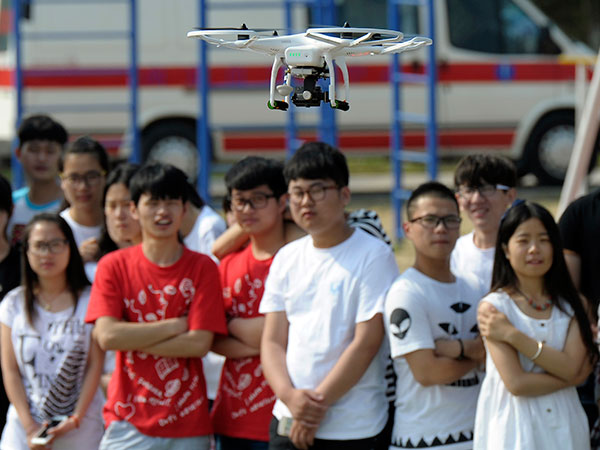


A group of people pose for a picture by using a drone camera in Nanjing, Jiangsu province. [Photo provided to China Daily]
China's drone producers are heading to the countryside as the government steps up restrictions on drone management in cities.
A provisional regulation on operating light-duty civilian drones, which will ban small unmanned aerial vehicles from delivering packages to urban residents, is being drafted by the Civil Aviation Administration of China.
The news was disclosed by an executive from the Aircraft Owners and Pilots Association of China earlier this month.
There have also been reports of urban drones interrupting the flight paths of aircraft or hitting high-voltage power lines.
According to Ke Yubao, executive secretary-general of the association, the detection and collision-alert systems on small drones are not good enough to avoid dense clusters of buildings and electricity cables. "A collision and crash will compromise the safety of people on the ground," Ke said.
DJI Technology Co, the world's biggest drone maker, based in Shenzhen, Guangdong province, is one of the companies turning to the rural market.
In November, it released its first farm drone product, which can spray pesticides over up to 4 hectares of land every hour-40 times more efficient than manual spraying.
Wang Fan, the company's public relations officer, said: "DJI achieved initial success with an unmanned aerial vehicle product in Europe. We only brought the product to the Chinese market after it gained popularity worldwide.
"For farm drones, however, we are starting with the domestic market."
The market logic is simple for the company-an aging society combined with fast urbanization has caused labor shortages in rural areas.
Wang Jinfu, vice-president of Zoomlion Heavy Industry Science &Technology Co Ltd, based in Changsha, Hunan province, said the mechanization of agricultural production has developed in line with expansion of production in the sector. According to the Ministry of Agriculture, by the end of last year the total area of arable land transfers reached 26.87 million hectares, enabling 3.41 million households to operate large areas of farmland.
"The standardized and mechanized production of agricultural products will ... enable more farmers to transfer to other sectors," Wang was quoted by Xinhua as saying last month.
 Charming female bodybuilders of Chengdu University
Charming female bodybuilders of Chengdu University Polish sports stars strip off for risqué calendar
Polish sports stars strip off for risqué calendar Spectacular aerial photos of the Three Gorges
Spectacular aerial photos of the Three Gorges Contestants of Mrs. Globe pose for photo in Shenzhen
Contestants of Mrs. Globe pose for photo in Shenzhen
 Bikini models attend hot pot banquet in Hefei
Bikini models attend hot pot banquet in Hefei J-10B fighters with homegrown engine in test fligh
J-10B fighters with homegrown engine in test fligh Photos of U.S. Navy intruding in South China Sea released
Photos of U.S. Navy intruding in South China Sea released Cats who immediately regretted their life choices in photographs
Cats who immediately regretted their life choices in photographs Beautiful girl from police college becomes Internet hit
Beautiful girl from police college becomes Internet hit Top 20 hottest women in the world in 2014
Top 20 hottest women in the world in 2014 Top 10 hardest languages to learn
Top 10 hardest languages to learn 10 Chinese female stars with most beautiful faces
10 Chinese female stars with most beautiful faces China’s Top 10 Unique Bridges, Highways and Roads
China’s Top 10 Unique Bridges, Highways and Roads Glacier under threat
Glacier under threat  This winter, chill out in Beijing’s hutongs
This winter, chill out in Beijing’s hutongs  Northeast China facing hard times: report
Northeast China facing hard times: report  Arms sales to Taiwan hinder Sino-US ties
Arms sales to Taiwan hinder Sino-US ties Day|Week